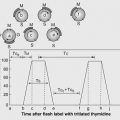15
EFFECTS OF TOTAL BODY IRRADIATION
SUDHA AMARNATH
Question 1
What is acute radiation syndrome (ARS)?
Question 3
At what dose level exposures would you expect the following syndromes to occur: cerebrovascular, hematopoietic, and gastrointestinal (GI)?
Question 1 What is acute radiation syndrome (ARS)?
Answer 1
ARS is defined as the biological changes and symptoms, including death, that can occur within weeks after a high-intensity total body irradiation exposure. The various forms of ARS arise based on the level of radiation exposure and at various time points after the exposure.
Hall EJ, Giaccia AJ. Acute radiation syndrome. In: Hall EJ, Giaccia AJ, eds. Radiobiology for the Radiologist. 7th ed. Philadelphia, PA: Lippincott Williams & Wilkins; 2012:114–128.
Question 3 At what dose level exposures would you expect the following syndromes to occur: cerebrovascular, hematopoietic, and gastrointestinal (GI)?
Answer 3
The cerebrovascular syndrome is associated with total body exposures in excess of 100 Gy and death typically occurs within 24 to 48 hours after the exposure. The GI syndrome is associated with more intermediate total body dose exposures (5–12 Gy) and death typically occurs within 9 to 10 days after exposure. The hematopoietic syndrome can occur after lower dose exposures (2.5–5 Gy) and if death occurs, it typically happens several weeks to 2 months after exposure.
Hall EJ, Giaccia AJ. Acute radiation syndrome. In: Hall EJ, Giaccia AJ, eds. Radiobiology for the Radiologist. 7th ed. Philadelphia, PA: Lippincott Williams & Wilkins; 2012:114–128.
Question 5
What factor(s) determine the time to onset, maximum severity, and duration of symptoms an exposed person will develop during the prodromal syndrome?
Question 7
What laboratory test can diagnose the acute radiation syndrome (ARS)?
Question 5 What factor(s) determine the time to onset, maximum severity, and duration of symptoms an exposed person will develop during the prodromal syndrome?
Answer 5
Depending on the dose level at the time of exposure, the time to onset, maximum severity, and duration of the symptoms that develop can vary. For example, at higher dose level exposures (10+ Gy), all exposed individuals will develop all prodromal symptoms within 5 to 15 minutes and these symptoms will peak at about 30 minutes and persist for a few days. This is then followed by a latent period and then the development of either the cerebrovascular syndrome or the GI syndrome (depending on the dose exposure). At lower doses, it becomes harder to predict the timing and severity of symptoms, but typically a presentation of more severe prodromal symptoms equals a poorer prognosis.
Hall EJ, Giaccia AJ. Acute radiation syndrome. In: Hall EJ, Giaccia AJ, eds. Radiobiology for the Radiologist. 7th ed. Philadelphia, PA: Lippincott Williams & Wilkins; 2012:114–128.
Question 7 What laboratory test can diagnose the acute radiation syndrome (ARS)?
Answer 7
The absolute lymphocyte count is the best and most useful lab test to diagnose ARS and determine the level of exposure. Circulating lymphocytes are one of the most radiosensitive cell lines and count levels can drop with exposures as low as 0.5 Gy. Chromosomal aberration analysis from cultured lymphocytes is the most widely used and accepted method of biological dosimetry and can detect dose exposures as low as 0.2 Gy of gamma- or x-rays.
Hall EJ, Giaccia AJ. Acute radiation syndrome. In: Hall EJ, Giaccia AJ, eds. Radiobiology for the Radiologist. 7th ed. Philadelphia, PA: Lippincott Williams & Wilkins; 2012:114–128.
Question 9
What are the symptoms associated with the cerebrovascular syndrome?
Question 11
What is the mechanism of tissue damage in the gastrointestinal (GI) syndrome?
Question 9 What are the symptoms associated with the cerebrovascular syndrome?
Answer 9
At doses high enough to cause the cerebrovascular syndrome (>40 Gy), all organ systems are seriously damaged and the exposed individual succumbs to death within 24 to 48 hours. Typically, an exposed individual develops severe nausea, vomiting, and abdominal cramping within minutes and then subsequently develops disorientation, loss of muscular coordination, difficulty breathing, hypotension, bloody diarrhea, seizures, coma, and ultimately death.
Hall EJ, Giaccia AJ. Acute radiation syndrome. In: Hall EJ, Giaccia AJ, eds. Radiobiology for the Radiologist. 7th ed. Philadelphia, PA: Lippincott Williams & Wilkins; 2012:114–128.
Stay updated, free articles. Join our Telegram channel

Full access? Get Clinical Tree






